 | 
| Niles Canyon Railway  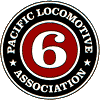 The Niles Canyon Railway lies about 9 miles due east of San Francisco Bay, in California, USA. The western terminus is at Niles in the city of Fremont while the depot at the other end of the line is in Sunol, California. From Niles to Sunol the line is approximately 7 miles long. From Sunol track continues east then north to Hearst Junction where there is a connection with the Union Pacific. The Canyon between Niles and Sunol holds the railway, a twisting scenic highway, and a second rail line of concrete ties with CWR (Continuous Welded Rail) belonging to Union Pacific, mostly invisible. The Niles Canyon Railway lies about 9 miles due east of San Francisco Bay, in California, USA. The western terminus is at Niles in the city of Fremont while the depot at the other end of the line is in Sunol, California. From Niles to Sunol the line is approximately 7 miles long. From Sunol track continues east then north to Hearst Junction where there is a connection with the Union Pacific. The Canyon between Niles and Sunol holds the railway, a twisting scenic highway, and a second rail line of concrete ties with CWR (Continuous Welded Rail) belonging to Union Pacific, mostly invisible. 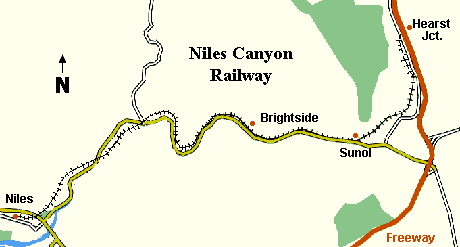 The Pacific Locomotive Association operates the Niles Canyon Railway with the goal of providing a working railroad museum for the benefit of the general public. The bulk of the association's railway equipment is stored at Brightside Yard located about halfway between Niles and Sunol. Scheduled passenger trains operate between Niles and Sunol. The current schedule may be found on their web site at: www.ncry.org Track was laid into the canyon in 1866 but further construction halted due to financial constraints. Four months after the famous golden spike ceremony at Promontory Summit the Central Pacific completed the transcontinental rail link between Sacramento and San Francisco Bay thereby finishing track through the canyon. The town that grew at the western end of the Canyon was named Niles after Addison C. Niles, a judge and former railroad attorney. When the Southern Pacific took over the Central Pacific the Niles Canyon route languished while their preferred route to the north prospered. In 1984 SP abandoned the Canyon and pulled up the tracks leaving the land to Alameda county. In 1987 the Pacific Locomotive Association came to an agreement with the county enabling volunteers to restore track in the Canyon. Trains now operate year round through Niles Canyon on this preserved section of the original transcontinental route. Steamfest 2 was a gathering of four tank locomotives at the Niles Canyon Railway to operate special trains on 14, 20, and 21 Mar 2010. One special train included a "quad-header", all four steam locomotives pulling one train. Several photo run-bys were performed of both passenger trains and a short freight train comprised of several cars. A passenger train would depart Sunol for Niles and stop along the line just east of the Niles wye to detrain passengers. It pulled west to the wye then waited while the freight train would run-by the assembled passenger/photographers beside the track continuing east to Brightside. Next the passenger train would run-by the passenger/photographers, stop, then reverse to re-board it's passengers. This was performed the morning and afternoon of 20 Mar 2010. Also, on the afternoon of 20 Mar 2010 all four locomotives were assembled in a "quad-header" at Sunol for a run to Hearst Junction that included a photo run-by for the paying passengers. 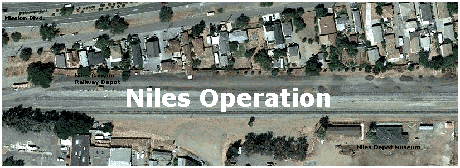 Click on the image above to see an animated view of the Niles operation. On Sunday, 21 Mar 2010, trains were operated for the public between Sunol and Niles, and Sunol to Hearst Junction. The Sunol to Niles trips were operated in a unique manner. The first east facing locomotive of the day departed Brightside Yard backing for the siding at Niles. It was followed by a passenger train pulled by one of the tank locos also backing towards Niles. Upon reaching end-of-track at Niles the first awaiting loco was coupled onto the front of the passenger cars while the second was uncoupled. The train then departed eastbound with the first engine leading in the normal manner. Meanwhile the second loco took water from a hose and moved into the siding to await the next train. This continued throughout the day for an uncounted number of trips. There were a large number of passengers boarding trains all day long. Here are the four tank locomotives that participated in Steamfest 2: 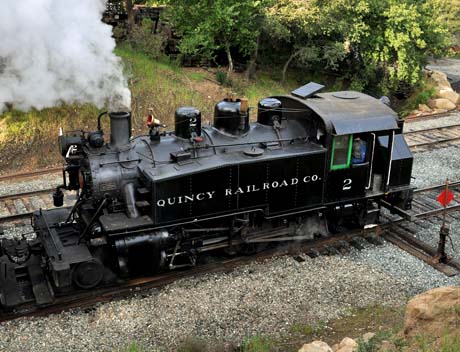 Niles Canyon Railway's Quincy Railroad No. 2 Builder ALCO Schenectady New York - Date 1924 - Type 2-6-2T - Cylinders 16 x 24 inches - Drivers 44 inches - Boiler pressure 180 psi - Gross weight 59.8 tons - Tractive effort 21,400 pounds. 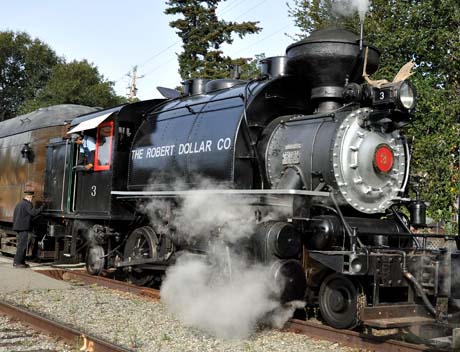 Niles Canyon Railway's Robert Dollar No. 3 Builder ALCO Schenectady New York - Date 1927 - Type 2-6-2T - Cylinders 15 x 24 inches - Drivers 44 inches - Boiler pressure 200 psi - Gross weight 65.5 tons - Tractive effort 20,900 pounds. 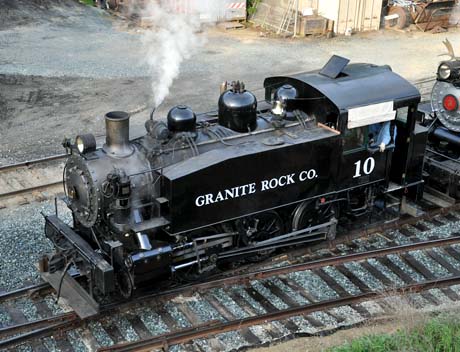 California State Railroad Museum's Granite Rock No. 10 Builder Porter - Date 1942 - Type 0-6-0T - Cylinders ? x ? inches - Drivers ? inches - Boiler pressure ? psi - Gross weight ? tons - Tractive effort ? pounds. Granite Rock No. 10 is a United States Army Transportation Corps (USATC) S100 Class 0-6-0T steam locomotive designed for use in Europe and North Africa during World War II for switching. Several were later used on railroads in Austria, Great Britain, France, Greece, Italy, Yugoslavia, and even China and Iran. In 1942 the USATC ordered 382 of the class from Davenport Locomotive Works of Iowa, H.K. Porter of Pittsburgh, and Vulcan Iron Works of Pennsylvania. They were built to a design by Colonel Howard G. Hill. They were then shipped to Great Britain in 1943 and stored there awaiting the invasion of Mainland Europe. After D-Day, they were shipped to Europe. After the war SNCF bought 77 and classified them as the SNCF 030TU Class. 15 were bought by the Southern Railway including one for spare parts, forming the SR USA Class. Austria had 10. 4 were sent to Italy. The Yugoslavians, where they were known as Class 62, assembled some more in the 1950s. Chinese had around 20 engines, forming the Chinese State Railways XK2 Class. Others found industrial use in Great Britain with the National Coal Board, Longmoor Military Railway, and Austin Motors. 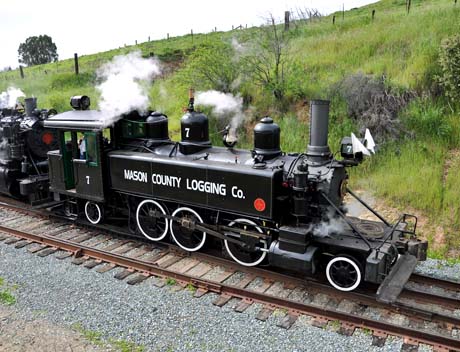 Roots of Motive Power Chris Baldo's Mason County Logging No. 7 Builder Baldwin - Date 1910 - Type 2-6-2T - Cylinders 15 x 22 inches - Drivers 44 inches - Boiler pressure 160 psi - Gross weight 46 tons - Tractive effort 17,000 pounds. 16 Jul 2009 - Henry Luna, Father of the Niles Canyon Railway Early 2010 - Steamfest II Flyer 19 Feb 2010 - Roots of Motive Power to Attend Niles Canyon... 4 Mar 2010 - Steam Locomotives, and Their Fans, to Gather in Sunol
Niles Canyon Railway California State Railroad Museum Central Pacific Railroad Golden Spike National Historic Site Roots of Motive Power Union Pacific |
